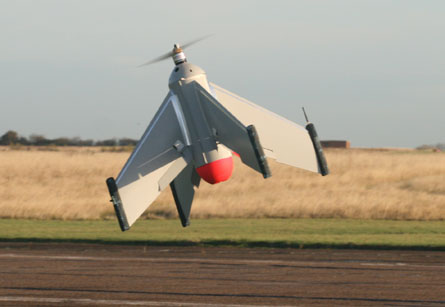Cranfield Aerospace has conducted a first series of flight tests with its Valkyrie vertical take-off and landing mini unmanned air vehicle, and is offering to develop an operational version for the UK armed forces.
Performed at Cranfield airport in Bedfordshire earlier this year using a 1.4m (4.6ft)-span proof-of-concept design, the activities were intended to support engineering activities linked to the perch-and-stare type's navigation and gust-insensitive control technologies.
"A small but successful number of flight tests" were made with the automated system, the company says, with the Valkyrie having carried an electro-optical camera. "We plan to enter the second phase of flight test later in the year, to address the difficult control issues of vertical landing in gusty conditions and implementation of further advanced control and navigation functions," it says.
 |
|---|
© Cranfield Aerospace |
Future flights are planned to be conducted on a test range, enabling the company to demonstrate the UAV's range and endurance characteristics. It hopes to secure Ministry of Defence backing to continue the project, which has so far been run using company funds.
Cranfield is offering to develop the scaleable design in support of intelligence, surveillance, target acquisition and reconnaissance tasks, and other potential applications, including during counter-terrorism operations. Air vehicles could also be equipped with an infrared camera or lightweight radar, it says, and a fully capable system made available by year-end.
"We have seen many UAV products that have had problems with launch and recovery, high dependence on flying skills and too much ground support equipment," says managing director David Gardner. "Valkyrie represents a real breakthrough in providing an easy to use piece of kit without the operational complexity and paraphernalia of the past."
The British Army began operating Honeywell's VTOL T-Hawk system in Afghanistan in April under an urgent operational requirement deal.
The design is described as being "highly effective" in supporting route-proving and counter-improvised explosive device work by the Royal Engineers, but is limited to operating in wind conditions of less than 10kt (18.5km/h).
Source: Flight International
















